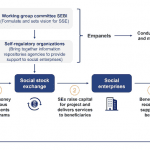Impact Investing in Financial Inclusion in Southeast Asia: Four Key Considerations for Investors and Enterprises
Southeast Asian countries, such as Singapore, Indonesia and Thailand, are witnessing a promising movement toward financial inclusion, driven by significant innovations in the digital finance space. This progress has been supported by national policies such as the implementation of regulatory sandboxes in the fintech sector, while the expansion of digital infrastructure has allowed financial services to reach many previously underserved populations in the region.
The expansion of access to financial products and services is especially crucial amidst negative shocks such as COVID-19, as it provides businesses and households with steady access to capital and savings, allowing them to remain resilient during economic slowdowns. With micro, small and medium-sized enterprises (MSMEs) in the Asia-Pacific employing an estimated 96% of working adults and contributing 42% of the region’s gross domestic product, their access to credit is crucial in sustaining economic growth.
But despite the momentum and potential of financial inclusion, its market growth is still not sufficient. In Indonesia, one of the countries that has seen the biggest growth in payment platforms, only 49% of adults have access to a formal bank account. In Cambodia, this number is even lower at 22%, and in the Philippines and Vietnam, it’s 34% and 31% respectively.
To reduce these gaps, we are seeing more impact investments into the financial inclusion sector in these countries. As I work with investors who are looking to address these inequalities in Asia, I have identified four considerations that prospective investors can take into account when deploying their capital toward financial inclusion in the Southeast Asia region.
Align the Impact Culture of the Investor and the Enterprise
When Aldi Haryopratomo started the digital services platform Mapan with an investment from Beau Seil, co-founder and partner at Patamar Capital, both parties shared a vision. They wanted to revolutionize Indonesia’s digital payment ecosystem by scaling mobile banking to underserved people across the country. Mapan was very successful, and it was able to scale and reach over 1.5 million low-income individuals and families in Indonesia. It was acquired by GoJek, Indonesia’s leading digital payments platform, in 2017.
Haryopratomo was able to successfully scale his small digital services platform to reach many previously underserved people because Mapan had the right foundation. From the beginning, Mapan and Patamar Capital established a shared impact culture and a common understanding: Each of them was willing to make difficult trade-offs, such as sacrificing short-term gains for long-term vision. For example, instead of becoming a high-interest lender that generates fast profits from customer loan repayments, Mapan chose to take a more patient approach. It offered affordable goods — ranging from clothing to refrigerators — to its clients so that families could increase their savings and become financially self-sufficient. This allowed it to expand and remain profitable in the long term while fulfilling its mission to improve the lives of Indonesians.
Focus on Customer-Centric Solutions
Putting the customer at the forefront of the investment is essential to filling the largest gaps in financial access. To that end, an investor may ask questions like: “Who am I serving?” “What financial products and services are missing?” and “How will this help them in the long-term?” It’s also essential to understand any unique challenges customers may face in a particular market. The case of Kim An Group in Vietnam has demonstrated the importance of understanding both the true needs of MSMEs and the local regulatory context when building a successful platform to serve them.
As Vietnam’s financial services sector is one of the most tightly regulated and controlled in the world, Kim An Group helps businesses overcome these barriers. Many MSMEs, which make up the backbone of the Vietnamese economy, are unable to access the capital necessary for expansion because they do not meet the stringent lending requirements of the banks. This forces them to turn to informal lenders, which can charge annual interest rates of up to 300%.
Kim An Group responded to this challenge by helping MSMEs obtain affordable, formal loans at market rates. By signing agreements with credit institutions, Kim An Group can co-develop tailored loans that offer entrepreneurs flexible and simplified payment schedules, depending on the cash flow of the business. This lending structure allows MSMEs to build financial discipline and resilience in the long term by providing them with the products and services that best fit their needs. With Kim An Group’s support, many entrepreneurs have been able to achieve their dream of starting a business. The company’s ability to effectively serve the needs of MSMEs by understanding their behavioral patterns and common challenges is one of the reasons it was able to secure a Series A investment from Patamar Capital last fall. To date, Kim An Group has facilitated over $60 million in loans to more than 26,000 borrowers.
Include a Gender-Lens to Empower Women Entrepreneurship
Women face three key barriers in accessing finance: difficulty in meeting eligibility criteria, a lack of customized products and services, and a technological access gap. Applying a gendered approach to investing in financial inclusion can bridge these gaps, and boost the economic status and autonomy of women in society.
More female-oriented startups are making strides to close this financial inclusion gender gap, by targeting specific issues that prevent women from accessing credit. For example, Lucy, a Singapore-based startup, uses an app to provide underserved female entrepreneurs with customer-centric financial services, from savings to remittances and credit. As explained by Lucy’s CEO Debbie Watkins, “Essentially, what we are doing is providing a range of very carefully tailored services to help female entrepreneurs at all socio-economic levels to start and grow their own businesses.” Lucy is currently in the trial process in Singapore but plans to expand to reach female customers throughout the region.
Invest in Quality over Quantity in Financial Products and Services
Financial inclusion investments should focus on long-term financial outcomes. This requires an emphasis on quality investments that allow individuals and businesses to better manage economic shocks and remain resilient. It is not just about access to finance, it is also about access to opportunity.
According to Noshin Nova, a research associate at the Global Impact Investing Network, it is not enough to simply quantify the number of loans disbursed by an investee company or the number of people who are given access to bank accounts. Instead, it is necessary to use indicators that capture what the loans were provided for, or show if they were offered at responsible interest rates or provided alongside bundled insurance or other impactful products.
As such, to better understand the extent of impact in inclusion efforts, investors can leverage emerging technology that not only collects and analyses data but also generates behavioral insights. For example, TNEX, Vietnam’s first digital bank, provides customers with app-based access to offers and products that match their daily financial and lifestyle needs — from payments and savings to buying food and entertainment. These services are delivered through an online marketplace supported by the bank, allowing merchants to post targeted offers in real-time to TNEX’s customers. This approach enables it to match its services to its customers’ preferences and lifestyles, truly adding value to the 40 million unbanked consumers that it hopes to serve.
Going forward, investors can link short-term outputs to longer-term outcomes by using loan quality report indicators, while improving the quality of capital and impact in the financial inclusion sector. While many companies and their investors have achieved much success, investors will still need to consider the long-term financial outcomes for customers in the broader ecosystem.
There’s no way around it; Collaboration is key
By harnessing these four key considerations, prospective investors and MSMEs can implement more effective strategies that promote interoperability, financial literacy and universal accessibility to sustainable financial products and services. This will require both investors and the businesses they support to work together. With effective collaboration, investors can draw on the insights and experiences that can only come from businesses with a close connection to customers, while these enterprises can benefit from the unique knowledge and essential financial support of the investment community. Only through active collaboration can we reach the last mile and revolutionize the way that people access, spend and save money, not only in Southeast Asia but around the world.
Komal Sahu is Chief of Sustainable Finance and Danielle Todesco is Junior Associate at AVPN, an Asian social investment network with more than 600 members across over 30 markets committed to moving their capital towards impact.
Photo courtesy of The Wandering Angel.
- Categories
- Finance, Investing, Social Enterprise



